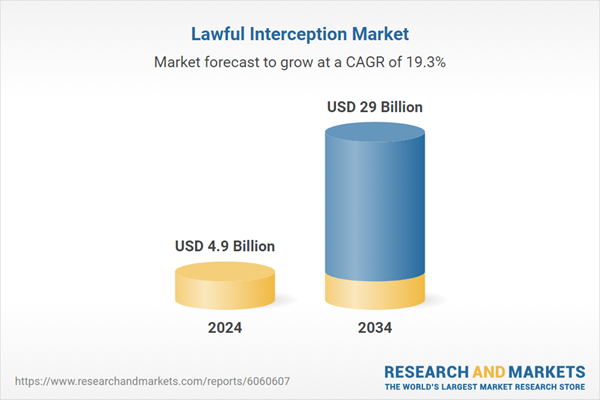The Lawful Interception Market was valued at USD 4.9 billion in 2024, and is projected to reach USD 29 billion by 2034, rising at a CAGR of 19.3%. This market growth is primarily driven by the rapid expansion of 5G technology, the surge of Internet of Things (IoT) devices, and the rising volumes of data traffic that are enhancing connectivity worldwide. However, the transition to 5G has introduced substantial security concerns, as the increased speed and reduced latency of these networks make them more vulnerable to exploitation by criminals and cyber threats. The global emphasis on improving cyber laws and regulations to address issues like cybercrime, terrorism, and other security threats is creating new opportunities for companies in the lawful interception sector. Governments worldwide have established stricter compliance requirements for telecom service providers to ensure that networks can accommodate lawful interception, all while balancing privacy concerns.
The lawful interception market is divided into solutions and services, with the solutions segment leading the market, accounting for USD 3.3 billion in 2024. This segment is projected to maintain its dominance, with a CAGR of 19.6%. Telecom providers, intelligence agencies, and governments focus on deploying advanced mediation devices, probes, and interfaces that ensure interception capabilities for voice, data, and video communication. These technologies help meet the growing demand for real-time monitoring, which is essential for national security, counterterrorism, and cybercrime prevention.
Additionally, the market is segmented by deployment modes into on-premises and cloud-based solutions, with on-premises systems commanding 73% of the market share in 2024. These solutions are crucial for real-time monitoring, which is integral to law enforcement and security operations. The increasing sophistication of cyber threats, along with the global expansion of IoT devices and the transition to 5G, is spurring innovation in interception technologies.
North America continues to lead the lawful interception market, driven by strict regulations such as the Communications Assistance for Law Enforcement Act (CALEA), which ensures compliance among service providers. As 5G networks and IoT devices become more prevalent, telecom providers and government agencies face the challenge of developing more advanced interception technologies to stay ahead of emerging security threats.
This product will be delivered within 2-4 business days.
The lawful interception market is divided into solutions and services, with the solutions segment leading the market, accounting for USD 3.3 billion in 2024. This segment is projected to maintain its dominance, with a CAGR of 19.6%. Telecom providers, intelligence agencies, and governments focus on deploying advanced mediation devices, probes, and interfaces that ensure interception capabilities for voice, data, and video communication. These technologies help meet the growing demand for real-time monitoring, which is essential for national security, counterterrorism, and cybercrime prevention.
Additionally, the market is segmented by deployment modes into on-premises and cloud-based solutions, with on-premises systems commanding 73% of the market share in 2024. These solutions are crucial for real-time monitoring, which is integral to law enforcement and security operations. The increasing sophistication of cyber threats, along with the global expansion of IoT devices and the transition to 5G, is spurring innovation in interception technologies.
North America continues to lead the lawful interception market, driven by strict regulations such as the Communications Assistance for Law Enforcement Act (CALEA), which ensures compliance among service providers. As 5G networks and IoT devices become more prevalent, telecom providers and government agencies face the challenge of developing more advanced interception technologies to stay ahead of emerging security threats.
Comprehensive Market Analysis and Forecast
- Industry trends, key growth drivers, challenges, future opportunities, and regulatory landscape
- Competitive landscape with Porter’s Five Forces and PESTEL analysis
- Market size, segmentation, and regional forecasts
- In-depth company profiles, business strategies, financial insights, and SWOT analysis
This product will be delivered within 2-4 business days.
Table of Contents
Chapter 1 Methodology & Scope
Chapter 2 Executive Summary
Chapter 3 Industry Insights
Chapter 4 Competitive Landscape, 2024
Chapter 5 Market Estimates & Forecast, by Component, 2021-2034 ($Bn)
Chapter 6 Market Estimates & Forecast, by Network Technology, 2021-2034 ($Bn)
Chapter 7 Market Estimates & Forecast, by Communication, 2021-2034 ($Bn)
Chapter 8 Market Estimates & Forecast, by Deployment Mode, 2021-2034 ($Bn)
Chapter 9 Market Estimates & Forecast, by End Use, 2021-2034 ($Bn)
Chapter 10 Market Estimates & Forecast, by Region, 2021-2034 ($Bn)
Chapter 11 Company Profiles
Companies Mentioned
The companies featured in this Lawful Interception market report include:- AQSACOM
- AT&T Inc
- Atos
- BAE Systems
- Cisco Systems
- ClearTrail Technologies
- Elbit Systems
- Ericsson
- Gamma Group
- Incognito Software Systems
- IPS S.p.A
- NetQuest Corporation
- NICE Systems
- Nokia
- SS8 Networks
- Trovicor Intelligence
- Utimaco
- Verint Systems
- Vocal Technologies Ltd
- ZTE Corporation
Table Information
| Report Attribute | Details |
|---|---|
| No. of Pages | 190 |
| Published | February 2025 |
| Forecast Period | 2024 - 2034 |
| Estimated Market Value ( USD | $ 4.9 Billion |
| Forecasted Market Value ( USD | $ 29 Billion |
| Compound Annual Growth Rate | 19.3% |
| Regions Covered | Global |
| No. of Companies Mentioned | 21 |









